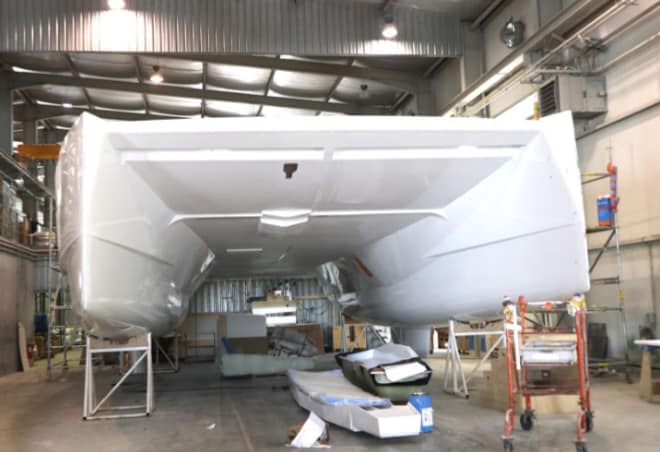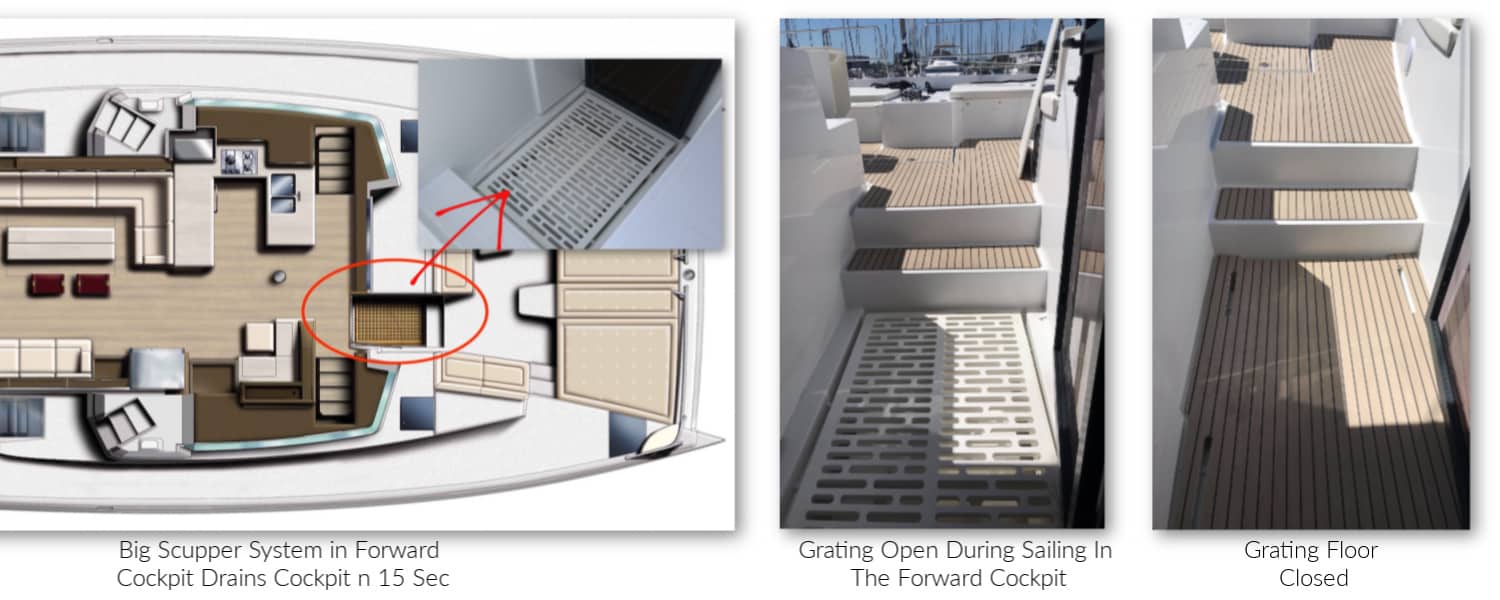For the last five or six years we have been told by interested Bali catamaran buyers that various “experts” including salespeople and dealers, have rumored that solid foredecks on cruising catamarans are dangerous, slam excessively, are unstable, and more. Some of these “experts” have gone so far as to publish shock-and-awe pictures such as a Ford F150 truck on the front of the boat to illustrate how much weight a solid foredeck adds on the front of the boat – obviously a very bad thing for catamarans.
Now that we have crossed the Atlantic in a Bali 5.4 experiencing a wide variety of sea conditions, we want to share our real world experience with the solid foredeck.
The Verdict: We loved it! We have now sailed 6,112 nautical miles on our Bali 5.4 from Europe, across the Atlantic, the Caribbean, and on to Florida. During this extensive sail under almost every weather condition, we never, at any time, had problems with the solid foredeck. To the contrary, we enjoyed the space while underway. It was one of the most loved spaces to hang out for all eight of our crew members! (Check out the video at left to find out why we loved it so much)!
After experiencing this solid foredeck first-hand, we feel that these uninformed opinions of “experts” do a great disservice to the boat-buying public. Instead of being objective and selling to the strengths and merits of each type or design of cruising catamaran, people criticizing the solid foredeck design try to scare buyers into buying their catamaran brand instead! Click on the link below to read more about our first-hand solid foredeck experience.
How Does The Solid Foredeck Measure Up?
Strength and Buoyancy
 With the development of very light and stiff infusion technology and foam cores, the need to use nets to reduce weight forward on cruising catamarans is no longer very important. One only has to look at the current cruising catamaran designs to see that the foredecks are getting bigger and trampoline nets are getting smaller. Some catamarans are now designed with merely “token” nets.
With the development of very light and stiff infusion technology and foam cores, the need to use nets to reduce weight forward on cruising catamarans is no longer very important. One only has to look at the current cruising catamaran designs to see that the foredecks are getting bigger and trampoline nets are getting smaller. Some catamarans are now designed with merely “token” nets.
Consider that a solid foredeck is much stronger than nets and crossbeams. The foredeck has buoyancy which nets do not have. When the bows with nets submerge, the only buoyancy you have is in the two bows. The nets do nothing to drive the bows upwards. Once the bows peg into a wave, you are relying on the buoyancy in the two bows to bring you back up.
With the Bali’s solid foredeck design, the deck and hull or “underbody” are one section with buoyancy. The angled underbody of the solid foredeck acts like an inverted spoiler so with the forward motion of the boat when the bows start submerging not only does this section present substantially more buoyancy, it also lifts or drives the bows upwards. Read the article where we explain how this platform is constructed. This buoyant quick recovery from wave penetration is what we experienced on our trip from France to Florida
Solid Foredeck Water Drainage System
The misleading “experts” will tell you that once the foredeck is swamped, the bows will be overloaded making the yacht unstable. They point out that catamarans with nets will shed the water instantly preventing this problem. We have owned catamarans with many different configurations of nets and agree that the drainage of an 80%-open-net deck is instantaneous. We have also owned catamarans with 40%-open nets which, while very comfortable to walk on, they do not shed the water as quickly as 80%-open nets. We’ve actually had the 40% nets ripped out by the weight of breaking waves.
So we understand why there is a concern that the solid foredeck will take on the water weight versus shedding it. And a frequently asked question about the Bali catamarans is how fast the solid foredeck or forward cockpit will shed the water when swamped. The answer is that it comes down to how effective the scupper or drainage system is. The drainage system on Bali Catamarans have grates, about 6′ long by 4′ wide, which drop the water into a scupper in the bottom of the bridgedeck. The water evacuation area is large enough for a person to pull their head and shoulders into. In addition separate drains in the anchor locker and chain locker assist with shedding water efficiently. The chain locker lid is designed to act as an additional scupper to drain water from the foredeck. So the drainage capacity is massive on the Bali foredeck.
We are told by Bali’s designer and naval architect that if a wave completely swamped the foredeck, the solid foredeck catamarans would take under 12 seconds to shed all the water. Our personal experience in the middle of the Atlantic is that the design is effective with no adverse instability predicted by solid foredeck naysayers. On our Bali 5.4, we took a big wave over the side of the boat onto the bow and the water disappeared almost instantly. The point of this discussion is to assess whether being swamped by a wave is dangerous on a solid foredeck vessel and we think the argument can be made that it is not.

Noise and Slamming Under the Solid Foredeck
Solid foredeck detractors claim that it causes slamming. Slamming occurs mainly under the bridgedeck where the bow waves converge and not at the front of the boat, so we consider this statement you hear often to be misleading. There is virtually no slamming that occurs forward on the chest of catamarans with a either solid foredeck OR netting because the buoyancy of the bows lifts the forward section of the boat as it goes into the swell. Therefore, while Bali boats do experience slamming when pounding into waves, it is no worse than any other catamaran in the same sea conditions. If anything, the slamming may be less considering the Bali has a very clean tunnel and the height ratio for the bridgedeck is above acceptable. Read about bridgedeck clearance.
Before we leave this topic, let’s point out another very important and practical point. On boats with nets, pounding into rough seas creates a lot of spray coming through the nets. The spray blinds the crew, covers the boat in saltwater, and is terribly uncomfortable if you leave venture on deck. With a solid foredeck, the foredeck remains dry and the crew are protected from being exposed to flying seaspray. Also, any noise from the spray hitting the bottom of the foredeck is inconsequential. Having owned and sailed many models of boats with and without nets, we have experienced both and assure you that the solid foredeck wins hands down.
Usable Space On The Solid Foredeck
 The foredeck becomes usable living space that can be taken advantage of even while underway. During our Atlantic crossing, we had our Thanksgiving barbeque on the foredeck in the middle of the ocean while sailing along between 8 and 10 knots (see the video above). This also became one of our crew’s most favorite places to relax and lounge or take naps durint the crossing.
The foredeck becomes usable living space that can be taken advantage of even while underway. During our Atlantic crossing, we had our Thanksgiving barbeque on the foredeck in the middle of the ocean while sailing along between 8 and 10 knots (see the video above). This also became one of our crew’s most favorite places to relax and lounge or take naps durint the crossing.
On the Bali 5.4, the walkthrough from the salon onto the foredeck makes it so easy to enjoy this space. And we never got splashed. The foredeck was dry and we were completely comfortable. This alone is the BEST selling point for the Bali catamaran range!
Summary: Solid Foredeck on a Catamaran
We bought the Bali 5.4 knowing that the foredeck was controversial. Little did we know that it is actually a favorite feature that we would be unwilling to give it up now that we have experienced it. We consider the solid foredeck a selling feature and will be very surprised if we do not see more catamaran manufacturers going in this direction.
Our extensive bluewater voyage of 6,112 NM which included a severe gale in the Mediterranean Sea (up to 45 knots), several squalls while transiting the Atlantic Ocean, and pretty severe beam seas and squalls in the Caribbean and North Atlantic. After this “test” aboard our Bali 5.4, we are sure that we have tested the boat on all points of sail. During our race-focused fast crossing as part of the ARC Rally, we found:
- The foredeck remained dry in virtually every situation. There was no spray or discomfort for the crew.
- We did not experience any excessive slamming, or more than any other cruising catamaran would experience in the same situations. We certainly did not experience any forward slamming under the angled solid foredeck.
- The structure is very solid. We felt at all times that the boat could handle whatever was thrown at it. The stiff structure proved very quiet with little to no creaking.
- When we did take a wave over the side onto the foredeck, the water shed almost instantly.
- On occasions when we surfed down into troughs, the buoyancy of solid foredeck came into play. We never pegged the bows or took water over the front of the boat including in the Mediterranean Sea with very steep seas and 45 knots of wind driving us from behind.
Having owned and sailed extensively offshore both foredeck designs (nets and solid), our opinion is that both are acceptable to us. We have no issues with either design. But, now we prefer the solid foredeck for the reasons shared above. The detractors of the solid foredeck may want to try the solid foredeck before making judgements. They may be very pleasantly surprised!
We Say: “Don’t Knock It Until You’ve Tried It!”





